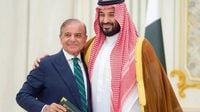South Asia’s strategic landscape has entered a period of acute volatility and transformation, as recent events and shifting alliances redraw the map of regional power. On October 7, 2025, a chorus of warnings and analyses from Islamabad, New Delhi, and beyond underscored just how precarious the balance between India and Pakistan has become — and how the repercussions might reach far beyond the subcontinent.
At the heart of the current storm is the enduring rivalry between India and Pakistan, two nuclear-armed neighbors whose historical grievances and territorial disputes have repeatedly brought them to the brink of war. The latest flashpoint, according to Kashmir Media Service and statements from the All Parties Hurriyat Conference-Azad Jammu and Kashmir (APHC-AJK), is the “provocative and irresponsible” rhetoric from India’s political and military leadership directed at Pakistan. Mushtaq Ahmad Butt, APHC-AJK Secretary Information, warned that this “war hysteria and aggressive posturing” risked pushing South Asia toward unnecessary confrontation and conflict, threatening not just regional but global security.
APHC-AJK leaders stated bluntly that India’s actions violate international law and the UN Charter. They further condemned what they described as ongoing human rights abuses in Indian-administered Jammu and Kashmir, including extrajudicial killings, arbitrary arrests, and collective punishments. “Such behaviour is a blatant violation of international law and the UN Charter and is unbecoming of a state that claims to be democratic and responsible,” Butt quoted APHC-AJK leaders as saying. They called on the United Nations and the UN Security Council to take immediate notice of India’s conduct, arguing that India’s provocations are not only destabilizing the region but are also a deliberate attempt to distract from internal political crises and an extremist agenda.
The roots of this antagonism are deep, and the Kashmir dispute remains the most combustible issue. Pakistan continues to advocate for a resolution in line with UN Security Council resolutions and the will of the Kashmiri people, while India maintains its position of managing the region militarily. According to The Express Tribune, India’s strategic approach is defined by a “hegemonic and zero-sum” mindset, seeking to establish political and military domination over its neighbors. The article further contends that India’s current political leadership, led by the Bharatiya Janata Party (BJP) and its Hindutva-driven ideology, has become a significant challenge to peace and stability in South Asia.
These tensions came to a head earlier in 2025 after a deadly terror attack in Jammu and Kashmir’s Anantnag district on April 22, which killed 26 people. The aftermath saw India launch Operation Sindoor on May 7, targeting terror hubs in Pakistan and Pakistan-occupied Kashmir (PoK). According to The Times of India, the Indian Air Force (IAF) conducted precision strikes on 11 Pakistani airbases, including strategic sites such as Nur Khan and Rahim Yar Khan, while intercepting all retaliatory drone and missile strikes from Pakistan. The IAF’s robust air defense played a crucial role in neutralizing these threats, and India released visual evidence of the damage caused by its cross-border operations.
The crisis escalated quickly, with both sides trading accusations and military blows. US President Donald Trump, in remarks reported by The Times of India, claimed credit for de-escalating the conflict using tariffs, stating, “If I didn't have the power of tariffs, you would have at least four of the seven wars raging. I use tariffs to stop wars. If you look at India and Pakistan, they were ready to go at it. Seven planes were shot down. They were ready to go at it. And then nuclear powers. I don't want to say exactly what I said, but what I said was very effective. They stopped. And that was based on tariffs.”
India, however, firmly rejected Trump’s claim. Officials insisted that the cessation of hostilities was achieved through direct talks between the Directors General of Military Operations from both countries, not because of US-imposed tariffs. Prime Minister Narendra Modi made it clear in Parliament that no foreign leader had asked India to halt Operation Sindoor, underscoring the sovereignty of the Indian decision-making process.
While the immediate crisis was contained, the underlying strategic realities have only grown more complex. The Express Tribune analysis paints a picture of a region where military power, rather than diplomacy, is increasingly the currency of interstate relations. India’s accumulation of advanced military hardware, rapid expansion of its nuclear and missile programs, and pursuit of offensive doctrines have, according to the analysis, emboldened its strategic community to believe in the possibility of coercing Pakistan — a dangerous miscalculation in a nuclearized environment.
Pakistan’s response during the crisis was characterized by restraint and discipline. The analysis notes that Pakistan “did not retaliate but responded,” exercising its right to self-defense under the UN Charter and launching Operation ‘Bunyan um Marsoos’ — a calibrated and precise military response. Pakistan’s conventional capabilities and resolve were demonstrated, forcing India to seek a ceasefire and reaffirming Pakistan’s status as a responsible nuclear power in the region.
Yet, the risks of escalation remain alarmingly high. The threshold for war between the two nuclear states has dropped, and any future conflict could spiral out of control with catastrophic consequences. The absence of effective arms control agreements and crisis management mechanisms only amplifies these dangers. The Express Tribune’s analysis concludes that “there is no space for even limited war between two nuclear states,” and that the concept of full-spectrum deterrence remains central to maintaining the fragile balance.
Amidst this backdrop, a new regional alliance has emerged that could further reshape the strategic calculus. On October 7, 2025, Quwa reported on the signing of a Strategic Mutual Defense Agreement between Pakistan and Saudi Arabia. This pact, analysts argue, is more than a routine formalization of ties; it signals a significant recalibration of regional power dynamics, driven in large part by the United States’ desire to pivot away from the Middle East and focus on countering China.
Under the new agreement, the US is effectively outsourcing Middle East security to regional partners, with Pakistan expected to play a larger role in Gulf security in exchange for economic and military support — possibly including advanced platforms like the J-35 fighter and HQ-19 SAMs. The move is designed to pull Pakistan’s strategic focus away from its eastern border with India and reorient it toward the Middle East. For Saudi Arabia, the pact provides a tangible security guarantee as American involvement wanes. For Pakistan, the deal offers economic relief and a diplomatic deterrent against Indian aggression, but it also carries significant risks, including potential over-commitment in volatile theaters such as Gaza and the possibility of alienating China.
The evolving multipolar global environment, with rising powers like China and Russia, has further complicated the South Asian security paradigm. The collapse of foundational arms control agreements, the proliferation of disruptive technologies like hypersonic missiles and AI-enabled drones, and the increasing use of disinformation and propaganda have blurred the lines between conventional and nuclear warfare. This, in turn, raises the stakes for any miscalculation or unintended escalation.
As the dust settles from the recent crisis, one message is clear: the margin for error in South Asia has never been narrower. Lasting peace, as many regional voices now argue, hinges on dialogue, political maturity, and the resolution of core disputes — especially Kashmir — in accordance with international law and the aspirations of the people. The coming months will test whether the region’s leaders can rise to this challenge or whether South Asia will remain a flashpoint with global consequences.

